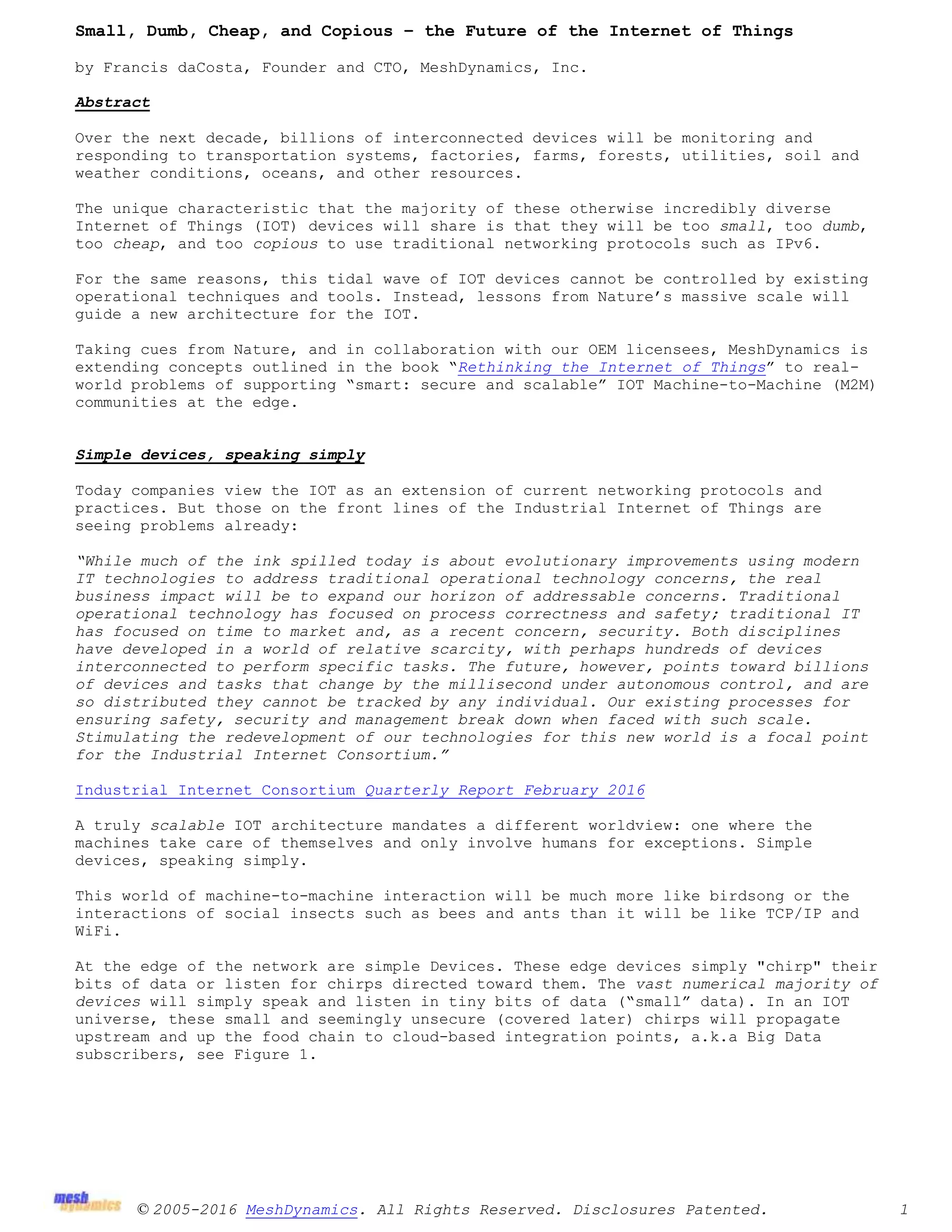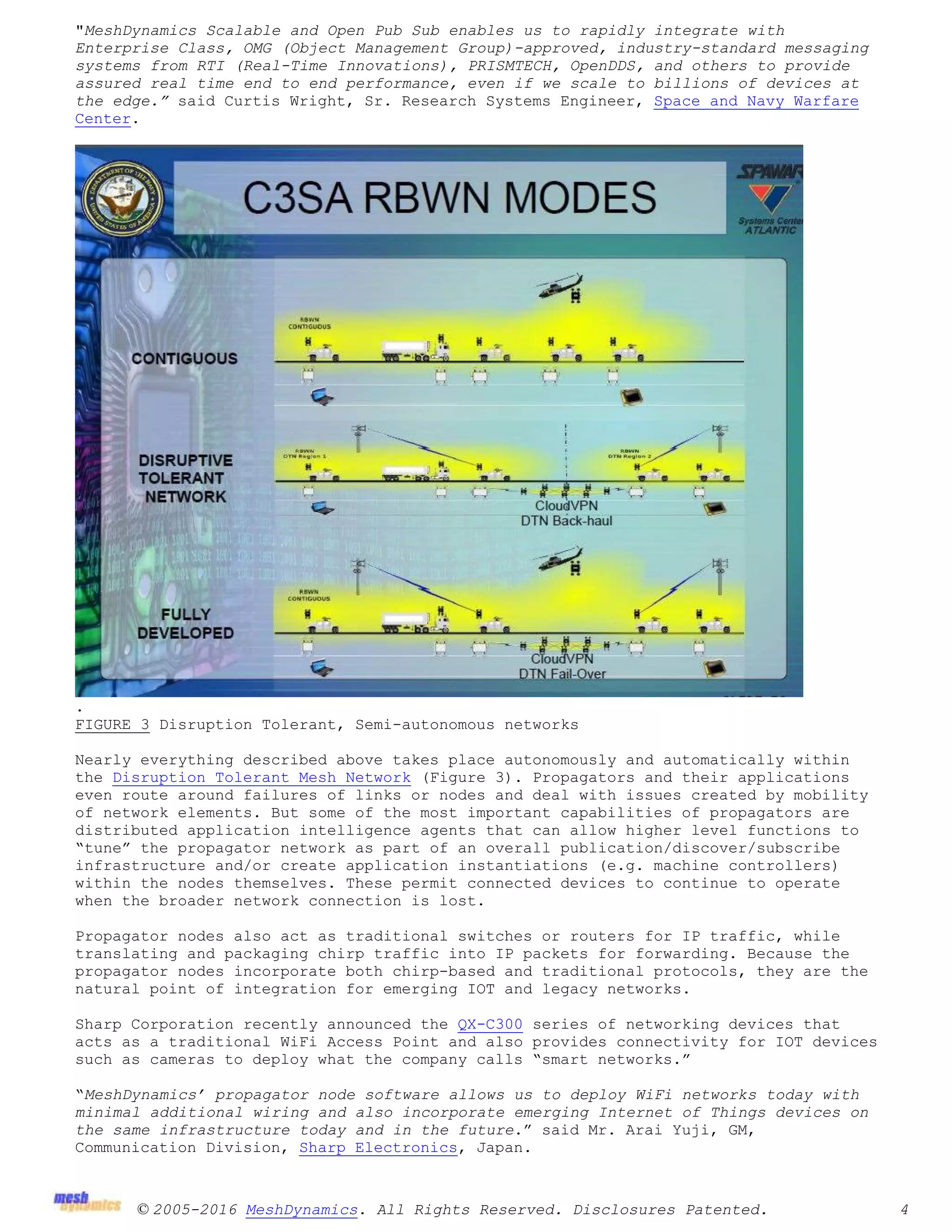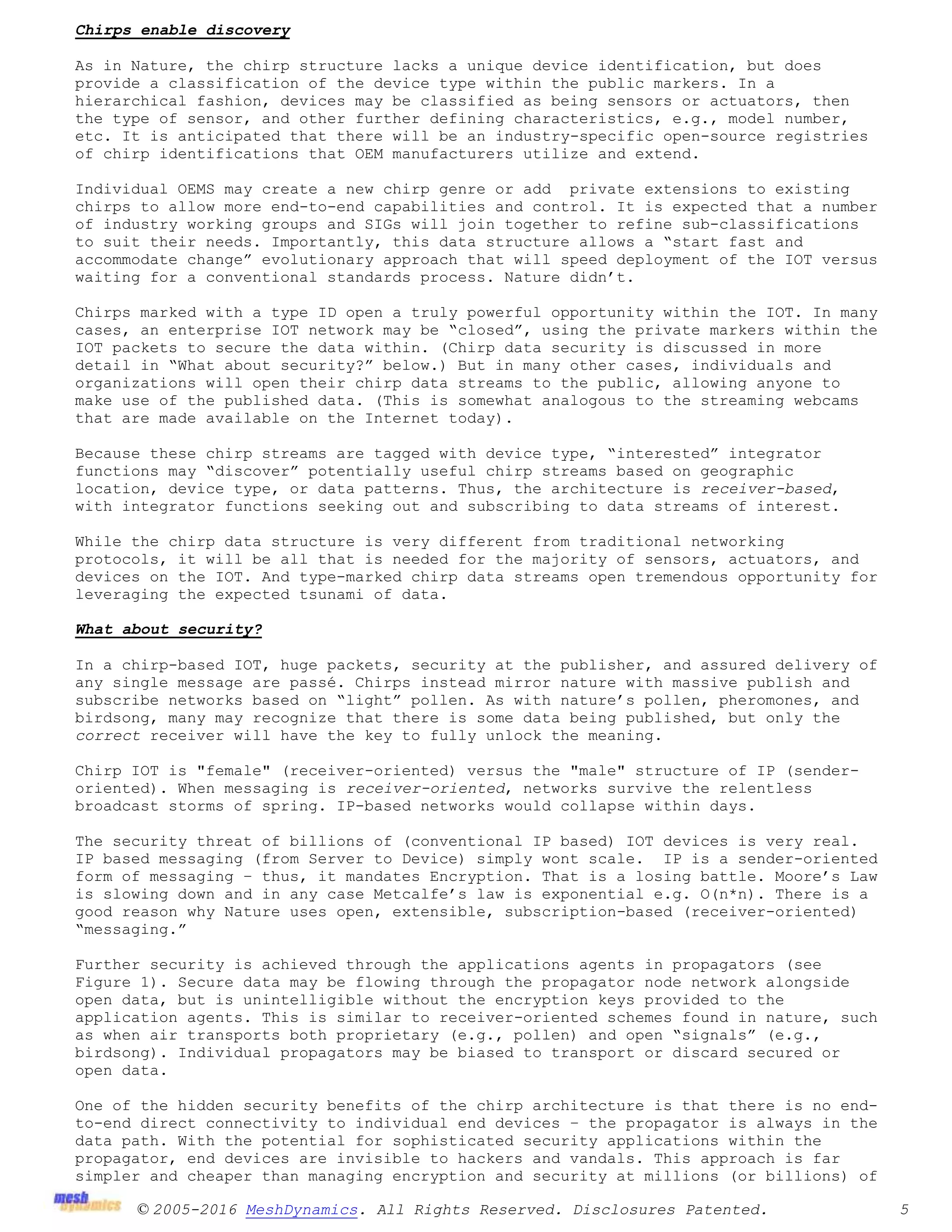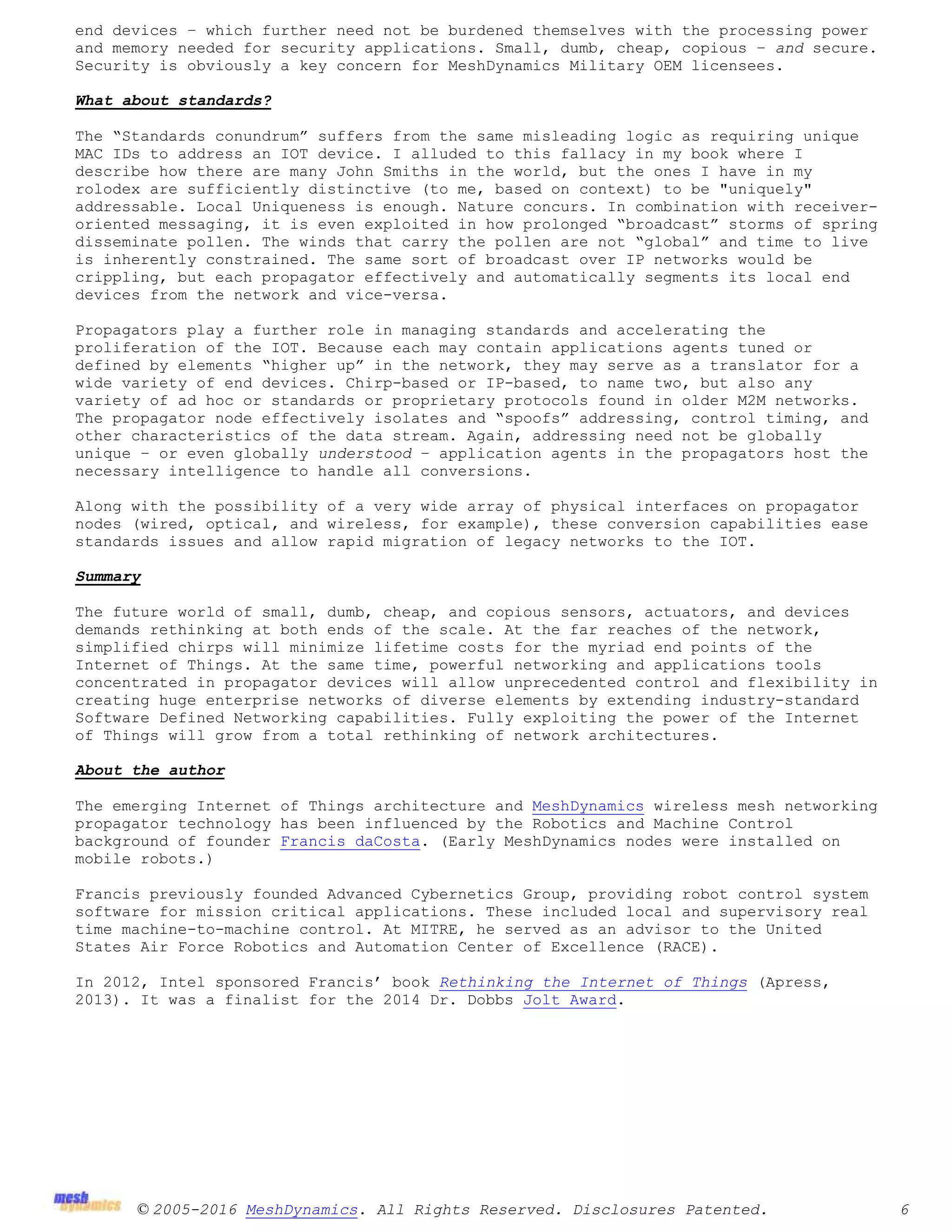The document discusses the future of the Internet of Things (IoT), focusing on the transition to small, inexpensive, and simple devices that require a new architectural approach for networking. It introduces the concept of 'chirps,' lightweight data packets that facilitate communication among billions of interconnected devices while addressing the limitations of traditional networking protocols like IPv6. The proposed architecture emphasizes a receiver-centric, distributed system that allows devices to operate autonomously and securely, leveraging concepts from nature to manage connectivity and data flow effectively.

![© 2005-2016 MeshDynamics. All Rights Reserved. Disclosures Patented. 2
FIGURE 1: Scalable and Secure Basic Architecture for IOT
Like Nature treats pollen, the (scalable) IOT must treat any single chirp as truly
"best effort" – so heavy broadcast storms caused by an external event will die out
pretty quickly. IOT chirps are digital pollen – lightweight, broadly “published”, with
meaning only to "interested" receivers/subscribers. Mimicking Nature, the IOT is
receiver-centric, not sender-centric (e.g. IP).
Seasonal or episodic broadcast storms from billions of these end devices are much less
of a problem because chirps are small and individually uncritical.
Pollen is lightweight because it is receiver-oriented. Security is inherent in its
“packet” structure. Also, no individual chirp message is critical so there's no need
for error-recovery or integrity-checking overhead (except for basic checksums).
Each IOT chirp message simply has some short and simple markers, a short and variable
data field, and a checksum. As described in my book, the simplest chirps may be only 5
bytes (contrast this with 40 bytes for the smallest sender-oriented IPv6 packet).
[Slides]
In contrast to the traditional Internet, error-checking, routing, higher-level
addressing, or anything of the sort are not needed. Edge devices are fairly mindless
"worker bees" existing on a minimum of data flow. This will suffice for the
overwhelming majority of devices connected to the IOT. (And for those more-
sophisticated applications where higher-level protocols are still needed and justified
by human interaction, IPv6 will do nicely.)
Chirps are what IP Datagrams were meant to be. The bandwidth savings are immediately
obvious, but pale in comparison to the reduction in memory, processing, and power
consumption compared to running an IP stack at each of myriad end devices. The cost
and complexity burden on the end devices will be very low, as it must be in the IOT.
The basic concept of chirps is not new. Terse M2M messaging is prevalent in all of our
purpose-built end devices and products that communicate – your TV remote, your car
subsystems, networked factories etc. Terse M2M messaging is how machines have
communicated since 8-bit microcontroller days. Challenges lies in scaling securely
what already works, but not reinventing it.
Publish, subscribe, and discovery for the edge
So if simple devices aren't capable of protocol intelligence, it must reside
somewhere. The major elements of that somewhere are the Level II Propagator nodes
Filter
Gateway
Integrator
Function
Chirp (and IP) Streams M2M “Small” Data Flows “Big” Data Subscribers
DEVICES PROPAGATORS INTEGRATORS
Tree Based Mesh Network
Application
s
Application
s](https://image.slidesharecdn.com/mesh-dynamics-futureofinternetofthings-230801161733-6ab6fe88/75/small-dumb-cheap-and-copious-the-future-of-the-internet-of-things-2-2048.jpg)
![© 2005-2016 MeshDynamics. All Rights Reserved. Disclosures Patented. 3
(Figure 1 and 2). These are like familiar networking equipment such as routers and
access points, but they operate in a different way.
Propagators listen for data "chirping" from any device. Based on a simple set of
“markers” in the chirps (described below), propagator nodes decide how to broadcast
these chirps to other propagator nodes and on to the higher-level Integrator
subscribers.
In order to scale to the immense size of the Internet of Things, these propagator
nodes must be capable of a great deal of discovery and self-organization. They must
recognize other propagator nodes within range, set up simple routing tables of
adjacencies, and discover likely paths to the appropriate integrators.
The key is building a logical tree-like topology from physically meshed propagators.
The topology algorithms have been tested and described in (more geeky) MeshDynamics
patents. [More]
FIGURE 2: Applications for Aggregation, Pruning and Real Time M2M “Shuttles”
Pub Sub aware Applications on the Propagator nodes serve as aggregation and pruning
“hubs”, see Figure 2. Chirps passing from-and-to end devices may be combined with
other traffic for forwarding. Applications provide this networking on behalf of
devices and integrators at levels "above" and "below" themselves. Any of the standard
networking protocols may be used, and propagator nodes will perform important
translation functions between different networks (power line or Bluetooth to ZigBee or
WiFi, for example), essentially creating small data “flows” from chirp data streams.
Other Trusted applications and agents, many residing inside the Propagators,
coordinate the function and control of dumb small, cheap, and copious IOT devices
through Software Defined Networking (SDN) paradigms for the edge.
MeshDynamics has been developing an open-source propagator platform for disruption
tolerant networking for the US Navy and US Department of Energy. Propagator nodes
support User Space Application Layer within an OpenWRT architecture for deep packet
inspection, SDN based routing, Video, IFTTT (conditional “If This Then That” rules),
etc. These propagator nodes provide autonomous, robust machine control with no
assurance of internet connectivity through the built-in applications agents.
The end result is a Publish/Subscribe (Pub Sub) network that can be extended from Big
Data servers all the way to the edge of the network while still maintaining a degree
of responsive local autonomy. A variety of standards-based SDN protocols may be
implemented on the distributed applications agents.](https://image.slidesharecdn.com/mesh-dynamics-futureofinternetofthings-230801161733-6ab6fe88/75/small-dumb-cheap-and-copious-the-future-of-the-internet-of-things-3-2048.jpg)


